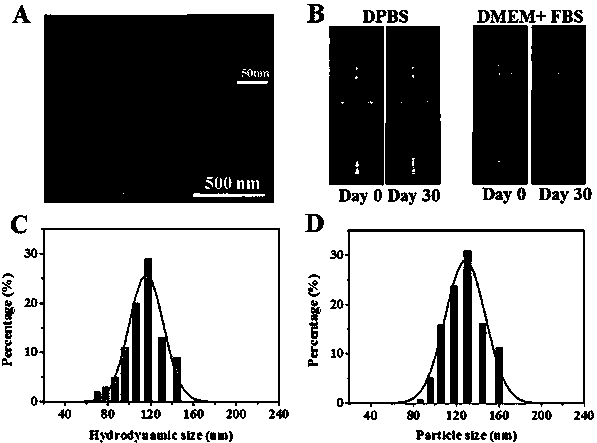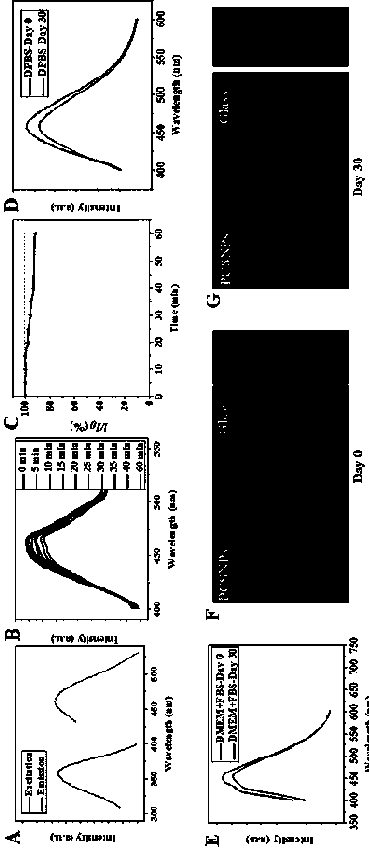Photoluminescent citric acid based nanoparticles and application and method for living cell marking
A technology of photoluminescence and citric acid, applied in the direction of luminescent materials, fluorescence/phosphorescence, chemical instruments and methods, etc., can solve the problems of weak fluorescence signal intensity, limit the application of quantum dots, poor photostability, etc., and achieve good biocompatibility properties, excellent photoluminescent properties, and good photostability
- Summary
- Abstract
- Description
- Claims
- Application Information
AI Technical Summary
Problems solved by technology
Method used
Image
Examples
Embodiment 1
[0031] Example 1 Preparation of photoluminescent citric acid-based nanoparticles
[0032] (1) Preparation of poly(citric acid-siloxane) polymer material: Add 1,8-octanediol, citric acid, and 3-aminopropyltriethoxysilane in a molar ratio of 1:1:0.4 to a 50mL flask and placed in an oil bath, the flask was heated to 160°C with stirring ° C, to be dissolved and then at 140 ° C for one hour to obtain a polymer, the whole process is carried out under the protection of nitrogen, the polymer is washed three times with deionized water, and it is freeze-dried for 48 hours to obtain a poly(citric acid-siloxane) polymer material ;
[0033] (2) Add 200 mg of the poly(citric acid-siloxane) polymer material obtained in step (1) into 10 mL of dimethyl sulfoxide, and stir with a magnetic stirrer for 30 minutes at room temperature to dissolve;
[0034] (3) Add the poly(citric acid-siloxane) solution in step (2) dropwise into 50mL of 1% polyvinyl alcohol solution at a stirring speed of 150 rp...
Embodiment 2
[0036] Example 2 Preparation of photoluminescent citric acid-based nanoparticles
[0037] (1) Preparation of poly(citric acid-siloxane) polymer material: Add 1,8-octanediol, citric acid, and 3-aminopropyltriethoxysilane in a molar ratio of 1.1:1:0.5 to a 50mL flask and placed in an oil bath, the flask was heated to 160°C with stirring ° C, to be dissolved and then at 140 ° C for one hour to obtain a polymer, the whole process is carried out under the protection of nitrogen, the polymer is washed three times with deionized water, and it is freeze-dried for 48 hours to obtain a poly(citric acid-siloxane) polymer material ;
[0038](2) Add 100 mg of the poly(citric acid-siloxane) polymer material obtained in step (1) into 10 mL of dimethyl sulfoxide, and stir with a magnetic stirrer for 30 minutes at room temperature to dissolve;
[0039] (3) Add the poly(citric acid-siloxane) solution in step (2) dropwise into 50mL of 1.5% polyvinyl alcohol solution with a stirring speed of 1...
Embodiment 3
[0041] Example 3 Preparation of photoluminescent citric acid-based nanoparticles
[0042] (1) Preparation of poly(citric acid-siloxane) polymer material: Add 1,8-octanediol, citric acid, and 3-aminopropyltriethoxysilane in a molar ratio of 0.9:1:0.2 to a 50mL flask and placed in an oil bath, the flask was heated to 160°C with stirring ° C, after dissolving at 140 ° C for one hour to obtain a polymer, the whole process is carried out under the protection of nitrogen, the polymer is washed three times with deionized water, and it is freeze-dried for 48 hours to obtain a poly(citric acid-siloxane) polymer material ;
[0043] (2) Add 300 mg of the poly(citric acid-siloxane) polymer material obtained in step (1) into 10 mL of dimethyl sulfoxide, and stir with a magnetic stirrer for 30 minutes at room temperature to dissolve;
[0044] (3) Add the poly(citric acid-siloxane) solution in step (2) dropwise into 50mL 0.5% polyvinyl alcohol solution, stirring at 150 rpm;
[0045] (4) ...
PUM
| Property | Measurement | Unit |
|---|---|---|
| concentration | aaaaa | aaaaa |
| melting point | aaaaa | aaaaa |
| melting point | aaaaa | aaaaa |
Abstract
Description
Claims
Application Information
 Login to View More
Login to View More - R&D
- Intellectual Property
- Life Sciences
- Materials
- Tech Scout
- Unparalleled Data Quality
- Higher Quality Content
- 60% Fewer Hallucinations
Browse by: Latest US Patents, China's latest patents, Technical Efficacy Thesaurus, Application Domain, Technology Topic, Popular Technical Reports.
© 2025 PatSnap. All rights reserved.Legal|Privacy policy|Modern Slavery Act Transparency Statement|Sitemap|About US| Contact US: help@patsnap.com



